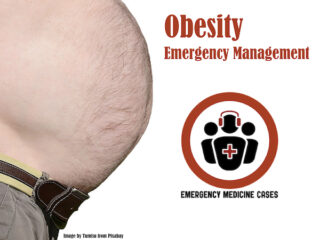Most Recent
Episode 69 Obesity Emergency Management
Current estimates of the prevalence of obesity are that a quarter of adult Canadians and one third of Americans are considered obese with approximately 3% being morbidly obese. With the proportion of patients with a BMI>30 growing every year, you’re likely to manage at least one obese patient on every ED shift. Obese patients are at high risk of developing a host of medical complications including diabetes, hypertension, coronary artery disease, peripheral vascular disease, biliary disease, sleep apnea, cardiomyopathy, pulmonary embolism and depression, and are less likely compared to non-obese adults to receive timely care in the ED. Not only are these patients at higher risk for morbidity and mortality, but obesity emergency management is complicated by the patient’s altered cardiopulmonary physiology and drug metabolism. This can make their acute management much more challenging and dangerous. To help us gain a deeper understanding of the challenges of managing obese patients and elucidate a number of important differences as well as practical approaches to obesity emergency management, we welcome Dr. Andrew Sloas, the founder and creator of the fantastic pediatric EM podcast PEM ED, Dr. Richard Levitan, a world-famous airway management educator and innovator and Dr. David Barbic a prominent Canadian researcher in obesity in emergency medicine from University of British Columbia....
Best Case Ever 39 – Airway Strategy & Mental Preparedness in EM Procedures with Richard Levitan
I caught up with airway educator, innovator and self-described enthusiast Dr. Richard Levitan at SMACC in Chicago this past June. In this Best Case Ever on Airway Strategy and Mental Preparedness in EM Procedures, Dr. Levitan uses a great save of his in a penetrating trauma case as a basis for discussion on mental preparedness and how we've been thinking about our general approach to emergency procedures the wrong way. Rather than fixating on the final goal of a procedure, which can often be daunting and lead us astray, he suggests a methodical incrementalized and compartmentalized approach to EM procedures that reduces stress and fear, improves confidence and enhances success. He runs through several examples including intubation, cricothyrotomy and initial approach to hypoxia to explain his Simple Incremental Approach to EM Procedures. Could this be a paradigm shift in the way we think about procedures in EM?....
Episode 68 Emergency Management of Sickle Cell Disease
A recent needs assessment completed in Toronto found that Emergency providers are undereducated when it comes to the Emergency Management of Sickle Cell Disease. This became brutally apparent to me personally, while I was researching this topic. It turns out that we’re not so great at managing these patients. Why does this matter? These are high risk patients. In fact, Sickle Cell patients are at increased risk for a whole slew of life threatening problems. One of the many reasons they are vulnerable is because people with Sickle Cell disease are functionally asplenic, so they’re more likely to suffer from serious bacterial infections like meningitis, osteomyelitis and septic arthritis. For a variety of reasons they’re also more likely than the general population to suffer from cholycystitis, priapism, leg ulcers, avascular necrosis of the hip, stroke, acute coronary syndromes, pulmonary embolism, acute renal failure, retinopathy, and even sudden exertional death. And often the presentations of some of these conditions are less typical than usual. Those of you who have been practicing long enough, know that patients with Sickle Cell Disease can sometimes present a challenge when it comes to pain management, as it’s often difficult to discern whether they’re malingering or not. It turns out that we’ve probably been under-treating Sickle Cell pain crisis pain and over-diagnosing patients as malingerers. Then there are the sometimes elusive Sickle Cell specific catastrophes that we need to be able to pick up in the ED to prevent morbidity, like Aplastic Crisis for example, where prompt recognition and swift treatment are paramount. A benign looking trivial traumatic eye injury can lead to vision threatening hyphema in Sickle Cell patients and can be easy to miss. In this episode, with the help of Dr. Richard Ward, Toronto hematologist and Sickle Cell expert, and Dr. John Foote, the Residency Program Director for the CCFP(EM) program at the University of Toronto, we’ll deliver the key concepts, pearls and pitfalls in recognizing some important sickle cell emergencies, managing pain crises, the best fluid management, appropriate use of supplemental oxygen therapy, rational use of transfusions and more...
Health Equity, Trust and Data Collection in the Emergency Department
I view the emergency department as a safe refuge, a modern-day secular sanctuary. We are the one health-care service that never turns anyone away; we provide shelter to the homeless on cold winter nights, safety for battered women, and food for the hungry. I have always felt this “sanctuary” role was part of the core mission of the ED, one with a great potential for improving lives, or at least providing comfort.
Best Case Ever 38 Sickle Cell Acute Chest Syndrome
Sickle Cell Acute Chest Syndrome remains the leading cause of death in patients suffering from Sickle Cell Disease. In his Best Case Ever, Dr. Richard Ward, a hematologist with a special interest in Sickle Cell Disease, describes a case of a Sickle Cell Disease patient who presents with what appears to be a simple pain crisis, but turns out to be a devastating Acute Chest Syndrome. He gives us the key clinical pearls and pitfalls to make this often elusive diagnosis early so that life-saving treatment can be initiated in a timely manner. This is in anticipation of the upcoming episode on The Emergency Management of Sickle Cell Pain Crisis with Dr. Ward and Dr. John Foote.
Journal Jam 4 – Low Dose Ketamine Analgesia
You’d think ketamine was in the ED drinking water! Not only has this NMDA receptor antagonist been used effectively for procedural sedation and rapid sequence intubation, but also, for delayed sequence intubation to buy time for pre-oxygenation, for life-threatening asthma as it has bronchodilatory and anxiolytic effects, for severely agitated psychiatric patients and excited delirium syndrome to dissociate them and get them under control; ketamine has even been used for refractory status epilepticus and for head injured patients as it is thought to have neuroprotective effects. The big question is: How effective is low dose ketamine analgesia for patients with moderate to severe pain in the ED as an adjunct to opiods? Low dose ketamine seems not only to help control pain, but it also has this almost magical effect of making patients indifferent to the pain. Pain is everywhere. And oligoanalgesia occurs in up to 43% of patients in EDs. Can we relieve suffering with low dose ketamine analgesia in the ED?....







